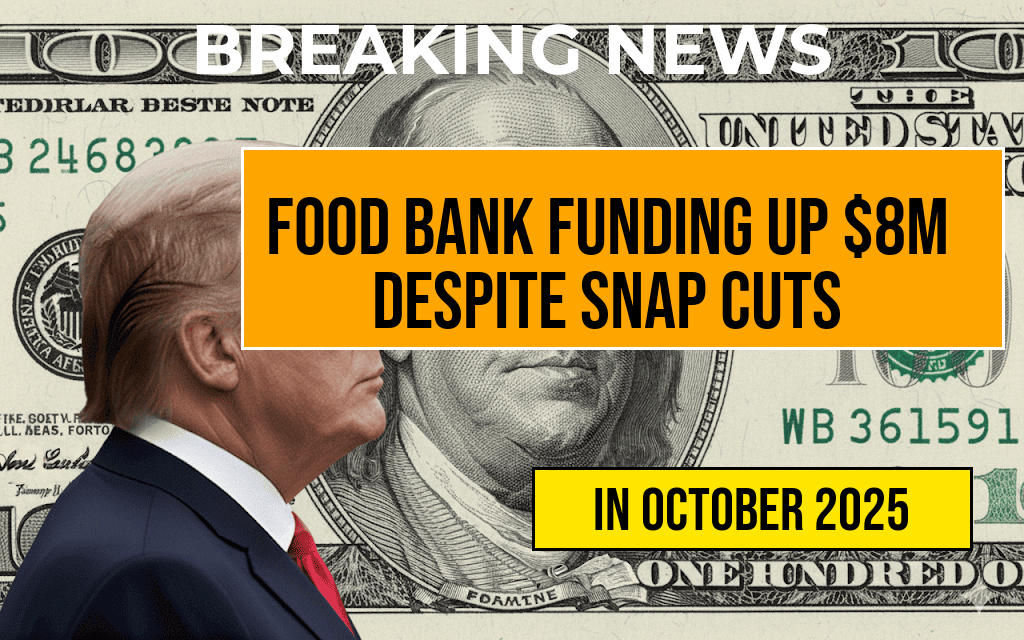Amid ongoing debates over federal nutrition assistance programs, recent developments reveal a significant shift in funding allocations for food aid initiatives across the United States. Despite proposed reductions to the Supplemental Nutrition Assistance Program (SNAP) budget, Congress has approved an additional $8 million in funding for food banks and related emergency food assistance programs. This increase aims to bolster support for millions of Americans facing food insecurity, especially as economic pressures continue to strain household budgets. The new funding package was secured through bipartisan negotiations, signaling a recognition of the vital role food banks play in supplementing government aid and addressing immediate nutritional needs. With the SNAP program facing potential cuts, advocates are emphasizing that community-based food assistance remains a crucial fallback for vulnerable populations, prompting policymakers to allocate additional resources to ensure access to nutritious food nationwide.
Background on SNAP Budget Cuts and Food Security Challenges
The SNAP program, the nation’s largest federal assistance initiative for low-income individuals and families, has faced proposed reductions in recent legislative sessions. Critics argue that tightening eligibility criteria and decreasing funding could leave millions without adequate support. According to the U.S. Department of Agriculture (USDA), approximately 42 million Americans rely on SNAP benefits, highlighting its importance in alleviating hunger and supporting economic stability.
However, opponents of expansion or increased funding contend that such measures could incentivize dependency and strain federal budgets. Meanwhile, economic indicators such as inflation, rising food prices, and stagnant wages have exacerbated food insecurity, with the Feeding America network reporting that over 37 million Americans, including 11 million children, are uncertain of where their next meal will come from.
Details of the $8 Million Funding Increase for Food Banks
Sources and Allocation
| Program/Area | Allocated Funds | Purpose |
|---|---|---|
| National Food Bank Network | $4 million | Supply chain logistics and emergency food reserves |
| Local Food Banks | $2.5 million | Operational costs and expanded distribution efforts |
| Community Outreach | $1.5 million | Food insecurity awareness campaigns and outreach programs |
The funding was allocated through a supplemental appropriations bill passed by Congress earlier this month, emphasizing a bipartisan commitment to addressing immediate nutritional needs amid ongoing debates over federal assistance programs. The Department of Agriculture will oversee the distribution process, ensuring that funds reach both large-scale distribution centers and local community organizations.
Implications for Food Assistance and Policy Debates
Supporters argue that increasing funding for food banks complements SNAP efforts and provides a safety net for those who fall through the cracks of federal programs. “Food banks are essential partners in our national effort to combat hunger,” stated Lisa Davis, director of the National Food Bank Alliance. “Additional resources enable us to respond swiftly to increasing demand, especially during economic downturns.”
Conversely, critics caution that reliance on private and community charitable organizations should not substitute for robust federal assistance. They warn that persistent SNAP reductions could undermine long-term efforts to reduce food insecurity and promote economic independence.
Legislators are divided on the issue, with some emphasizing the need for sustainable solutions that address the root causes of poverty, such as affordable housing and job creation, alongside immediate food aid provisions. The recent funding boost underscores the complex balancing act policymakers face: supporting vulnerable populations without expanding government dependence.
Community Impact and Future Outlook
Local food banks have reported increased demand over the past year, with many struggling to meet the rising needs of their communities. The additional $8 million is expected to bolster inventory levels, expand distribution hours, and fund outreach efforts to reach underserved populations.
State and local governments are also exploring partnerships to maximize the impact of this funding, with some regions planning to establish mobile food pantries and community-based nutrition education programs. As economic challenges persist, the role of food banks as a critical component of the social safety net is likely to grow, even as discussions around federal assistance reforms continue.
For more information on food insecurity and federal nutrition programs, visit Wikipedia’s overview on food insecurity or the USDA Food and Nutrition Service.
Frequently Asked Questions
What is the main reason for the increase in food bank funding?
The food bank funding has increased by eight million dollars to address the impact of SNAP budget reductions and ensure continued support for those in need.
How do SNAP budget reductions affect food assistance programs?
SNAP budget reductions can lead to decreased benefits for recipients, increasing the demand on food banks to fill the nutritional gap for vulnerable populations.
What is the intended use of the additional eight million dollars in funding?
The additional funding aims to strengthen food banks, expand their capacity, and improve food distribution services to meet the rising needs caused by SNAP reductions.
Who benefits from the increased funding for food banks?
The beneficiaries include low-income families, elderly individuals, and people experiencing food insecurity who rely on food banks for essential nutrition.
Are there any long-term strategies mentioned to address food insecurity?
While the article focuses on the funding increase, it also emphasizes the importance of policy measures and community support to sustainably reduce food insecurity in the long term.







